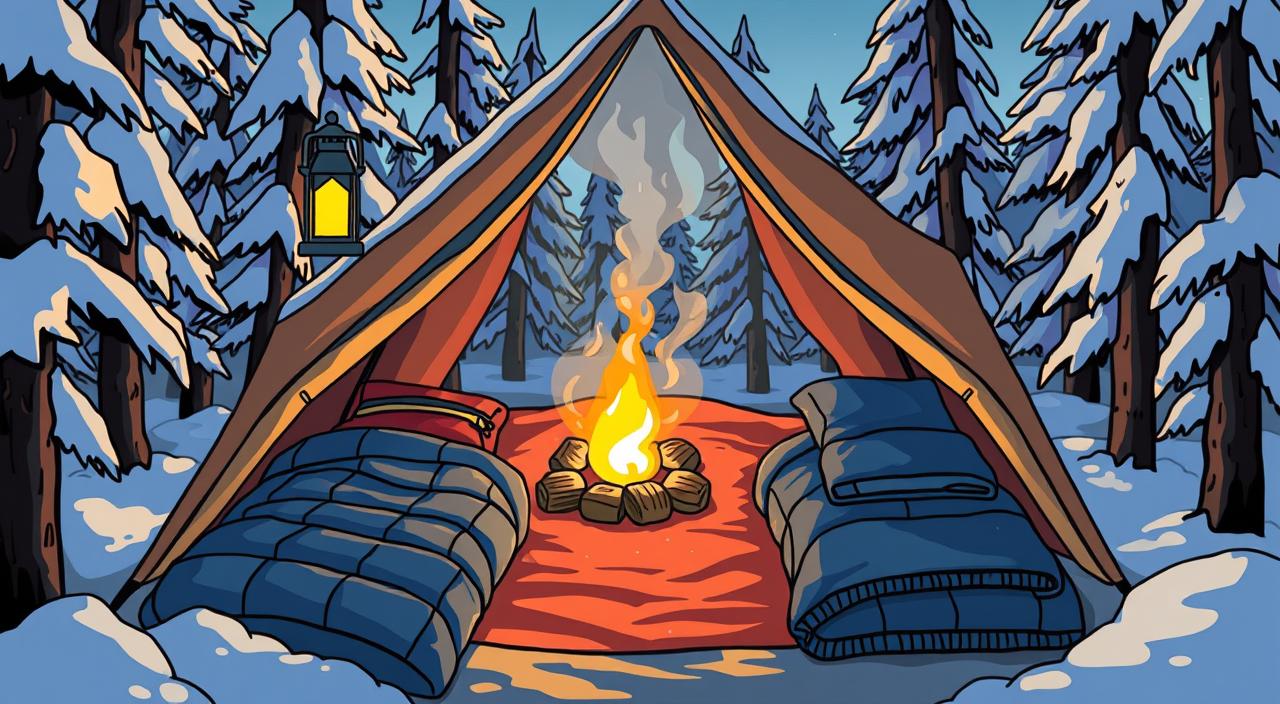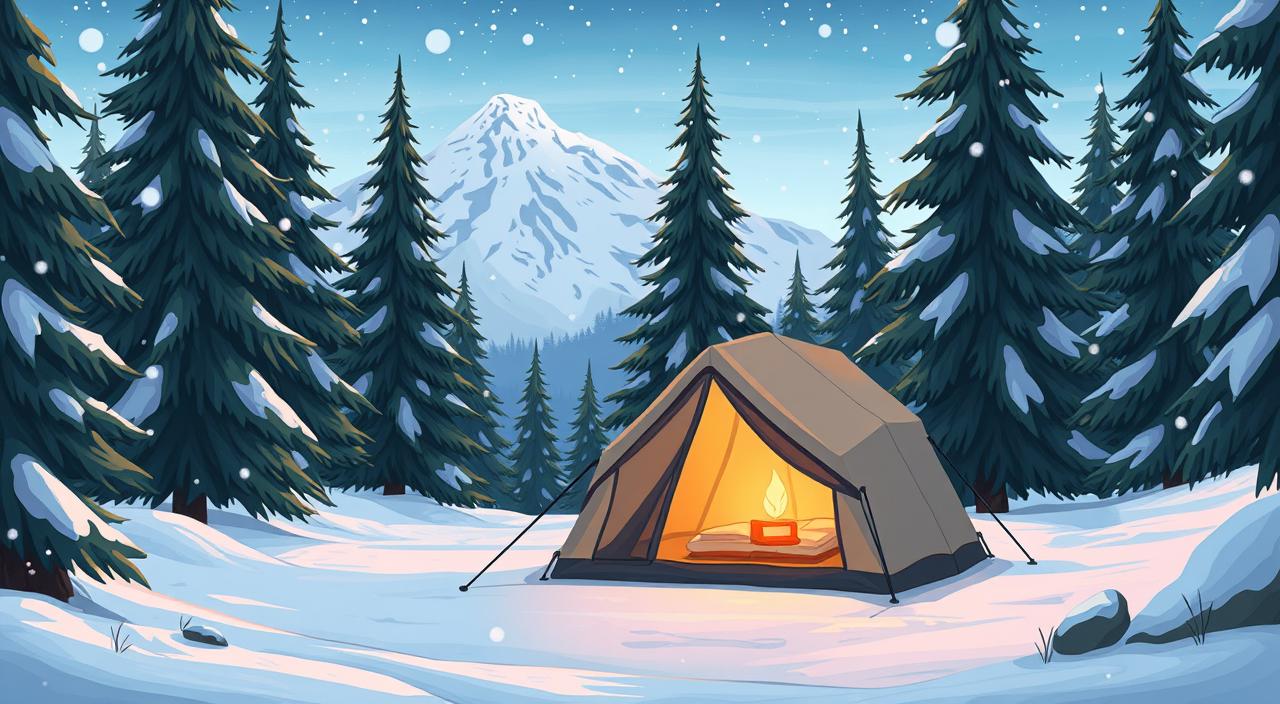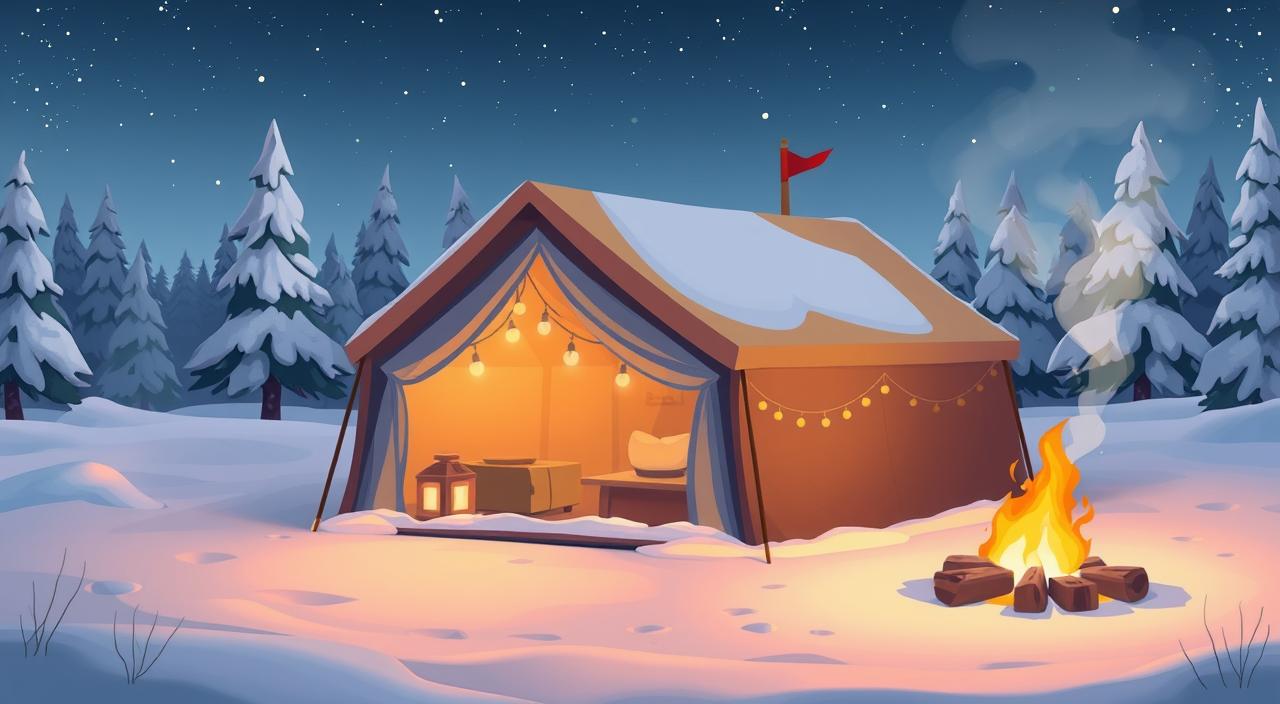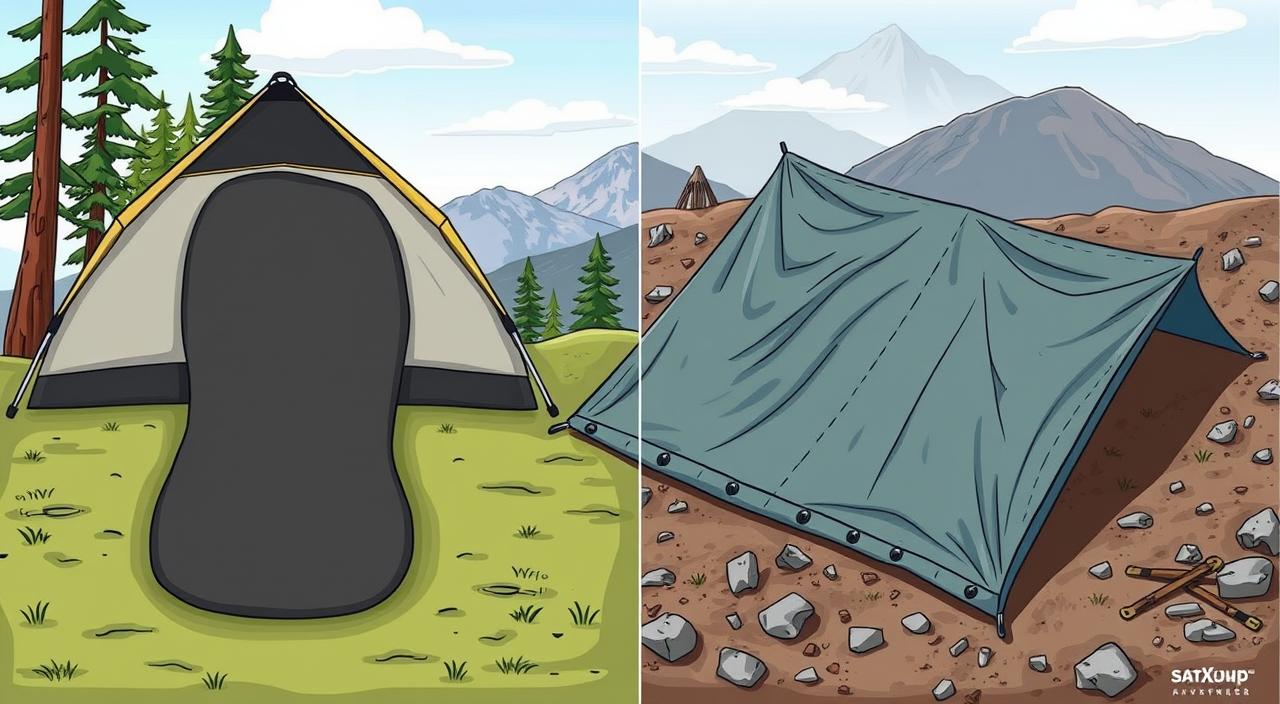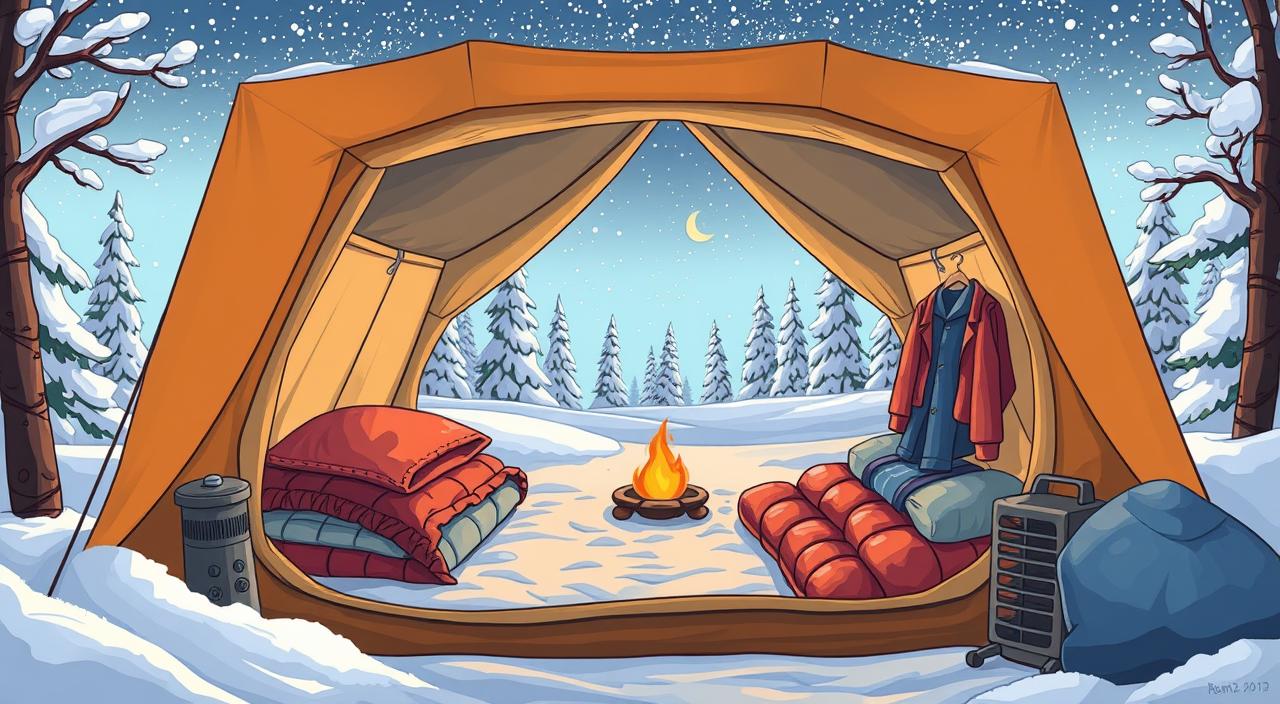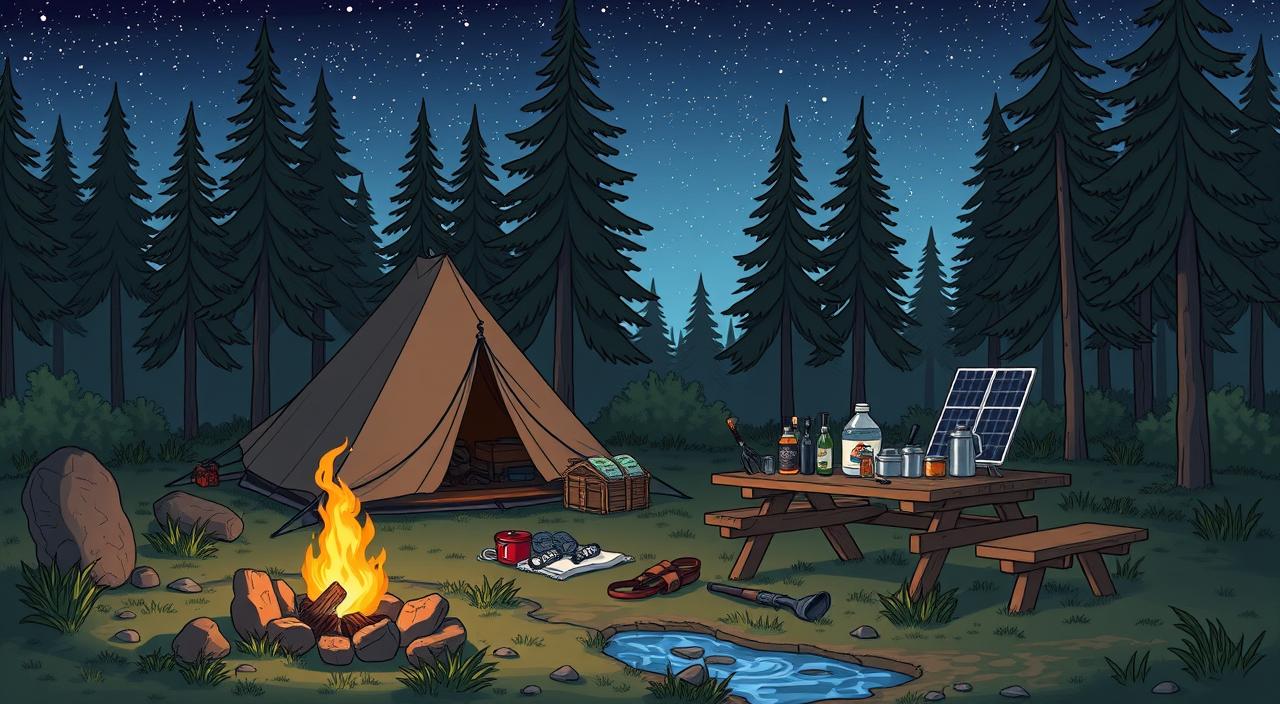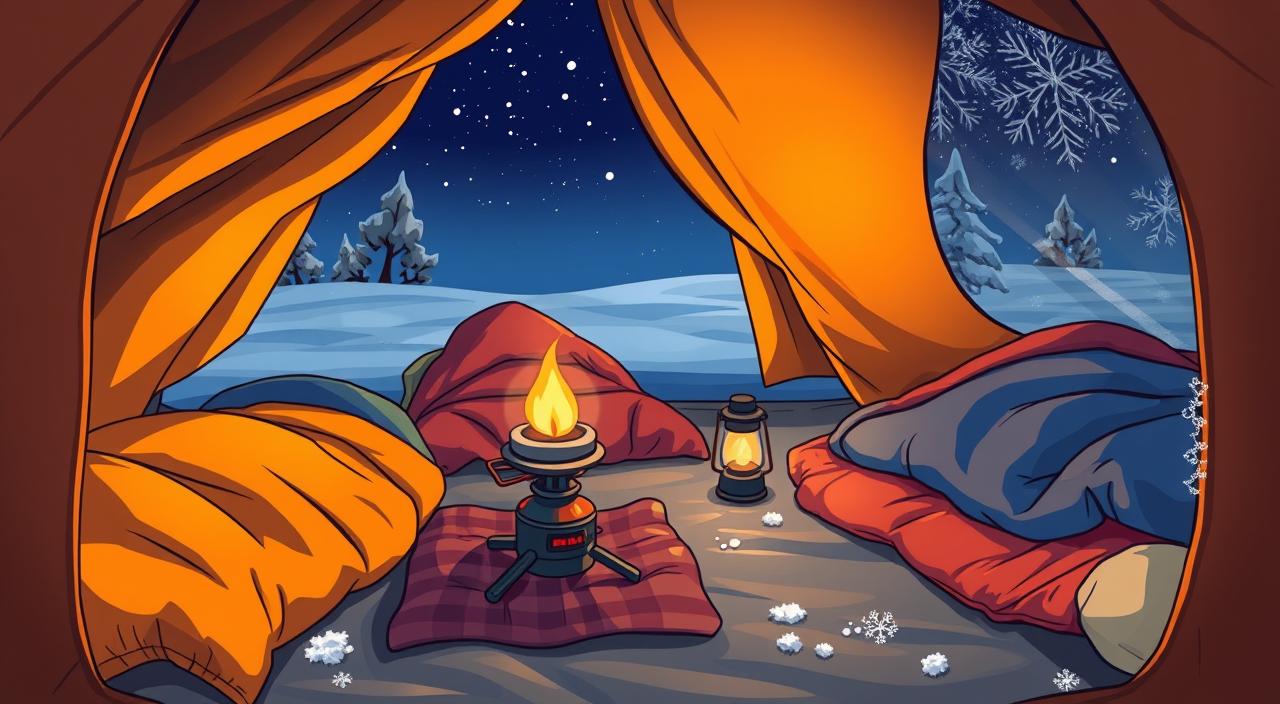
Disclaimer: This post may contain affiliate links. As an Amazon Associate, we earn from qualifying purchases.
Are you ready for the cold while camping, or will you be shivering all night? Learning how to keep your tent warm is key for a cozy and safe trip. Camping in winter can be fun and exciting with the right gear and techniques. This guide will show you how to stay warm and comfortable in your tent.
No more waking up cold. Let’s look at ways to keep your tent warm and cozy!
Key Takeaways
- Nylon and polyester are preferred materials for winter tents due to their lightweight and moisture resistance.
- Using dome-shaped tents can significantly reduce heat loss compared to cabin-style tents.
- Reflective Mylar blankets can reflect up to 90% of your body heat.
- Investing in insulated sleeping pads with higher R-values enhances warmth.
- Hot meals and warm beverages before bed can help maintain body temperature.
The Importance of Staying Warm While Camping
Camping in cold places brings special challenges that need careful planning. Staying warm is key to both comfort and safety. Not having enough warmth can lead to serious issues like hypothermia, which can happen fast if you’re not ready for the cold. The right steps help you sleep well and enjoy your outdoor adventure.
Knowing how to keep your tent warm is vital. Simple steps can make a big difference, like using sleeping pads with an R-value over 4 to keep heat in. Pick a campsite that shields you from strong winds and gets sunlight. Adding tent rugs or footprints can also help keep you warm by insulating you from the cold ground.
Having more people in a small tent can warm it up with shared body heat. Choose sleeping bags with a down and synthetic mix that suits the weather. Being ahead on warmth not only makes camping better but also keeps you safe in the cold.
How to Keep Tent Warm: Essential Tips for Cold Weather Camping
Camping in the cold needs more than just the right gear. You must have a plan to stay warm. Start by picking a 4-season canvas tent that’s heavy enough to keep out the cold. It should weigh 8-11.5 ounces per square yard. Also, choose a tent that fits just one or two people to keep the heat in better.
When it comes to sleeping, pick insulated pads with an R-value of 4 to 6. These are perfect for winter camping. For sleeping bags, pick ones rated for temperatures lower than what you expect. Down quilts are also great because they’re warm without being heavy.
- Invest in high-calorie hot meals, like chili or stew, as they help maintain body warmth.
- Consume warm beverages such as tea or coffee for additional comfort.
- Engage in light physical activities before settling down for the night to elevate your body temperature.
Wear clothes made of moisture-wicking synthetic fabrics or wool to stay warm at night. Cotton can make you colder because it holds moisture. Use roll mats under your sleeping bag to keep your feet warm.
For keeping your tent warm, managing moisture is key. Make sure your sleeping bag isn’t too tight to keep air flowing. Also, shake out your sleeping bag before sleeping to make it work better.
Keep these tips in mind, and you’ll be ready for the cold. You’ll have a warm and cozy camping trip.
Insulating Your Tent for Maximum Warmth
To stay warm while camping in the cold, focus on effective tent insulation. Insulating your tent helps keep you warm all night. Choosing the right tent and adding extra insulation can make your camping trip better.
Choosing the Right Tent for Cold Weather
Choosing the right tent is key for winter camping. A four-season tent is best for harsh weather like high winds and heavy snow. It’s better than three-season tents. Look for brands like Mountain Hardwear, NEMO, The North Face, and Hilleberg.
A smaller tent is also good because it keeps your body heat in. It has less space, which helps keep warmth in.
Using a Footprint or Ground Tarp
Using a footprint or ground tarp adds an extra layer of insulation. It keeps your tent warm by blocking cold ground temperatures. This layer also helps keep the heat inside your tent, making it cozier.
Insulated foam sleeping pads are great for winter camping too. They add an extra layer of insulation at the bottom of your tent.
Investing in High-Quality Sleeping Systems
Your sleeping system is key to staying warm on cold nights outdoors. Choosing the right gear is crucial for comfort and protection from the cold. Start by picking high-quality sleeping systems that fit your camping style and preferences.
Picking the Right Sleeping Bag
A good sleeping bag can make a big difference in how warm you stay. Find a bag made for temperatures lower than what you expect. The Sea to Summit Ascent Women’s 15-degree Down Sleeping Bag is light at 1 lb. 12 oz and folds small, perfect for camping. It’s also made with down that meets ethical standards.
Choosing an Insulated Sleeping Pad
An insulated sleeping pad is key to staying warm while you sleep. Choose a pad with a high R-value to keep heat from escaping to the ground. The Sea to Summit Women’s Comfort Plus Self-Inflating Sleeping Mat has an R-value of 5.1, great for all seasons. Look for a pad that offers both comfort and insulation for better sleep.
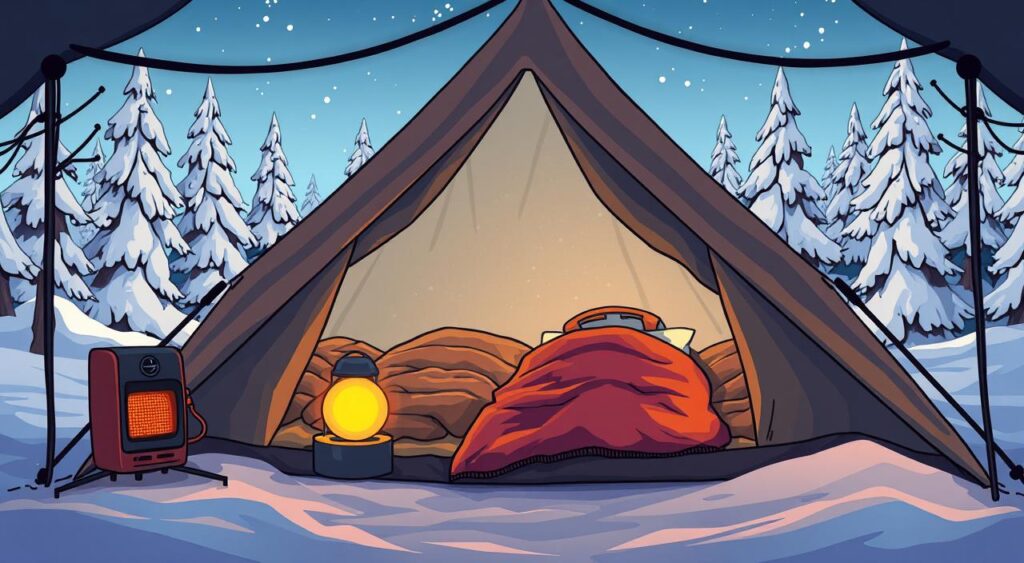
| Sleeping Bag | Weight | Temperature Rating | Compression Size |
|---|---|---|---|
| Sea to Summit Ascent Women’s 15-degree Down Sleeping Bag | 1 lb. 12 oz | 15°F | Size of a water bottle |
| Nemo Disco 15 | 2 lb. 2 oz | 15°F | Backpack-friendly |
| North Face Eco Trail Bed 20 | 3 lb. 6 oz | 20°F | Compact size |
With the right sleeping bag and pad, your camping trips will be more comfortable and warm. Enjoy the outdoors with peace of mind.
Effective Tent Heating Methods
Staying warm while camping in cold weather is key. Choosing the right heating method can greatly improve your comfort. It’s important to know how to use tent heaters safely and find other ways to stay warm.
Using a Tent Heater Safely
The Mr. Heater Little Buddy is a top pick for campers, costing $105 and providing 3,800 BTU for about five hours. It has safety features like auto-shutoff for tipping over and oxygen level sensors. For more heat, the Mr. Heater Buddy offers 9,000 BTU for around $130.
Always use heaters safely by ensuring good ventilation to avoid carbon monoxide buildup. Never leave heaters running without someone watching.
Heat Rocks and Other Alternative Heating Sources
Heat rocks are a great choice for a more natural way to warm up. Heat them by your campfire and put them in your tent for warmth. This method is safe and doesn’t need extra gear, adding to the camping experience.
You can also use the heat from a campfire under your tent or make a simple fire reflector for warmth. Combine these with the right clothes for a cozy and safe camping trip.
Warm Clothing Hacks for a Cozy Night
When you’re camping in winter, staying warm is key. Using warm clothing hacks can make a big difference in your comfort. Start by layering your clothes well, which is key to keeping warm. Begin with a thermal base layer to keep in the heat.
Then, add wool or fleece for extra insulation. Don’t forget to focus on your hands and feet. Wool socks, gloves, and a hat will help keep the heat in.
When it’s time to sleep, don’t overdress in your sleeping bag. Keep your base layer on to let the bag trap heat. Also, keep wet items like gloves and socks in your sleeping bag to dry them with your body heat.
Keep your electronics close to your body or in your sleeping bag to keep them warm. Bringing your ski boots inside the tent makes getting ready in the morning easier. Also, wearing hut booties around the campsite adds to the coziness.
Plan your food and drinks for cold weather carefully. High-calorie meals and hot tea will keep you warm and energized. Remember, olive oil can help your body generate heat, which is great with your cold weather gear.

| Warm Clothing Tips | Purpose |
|---|---|
| Layering with thermal and fleece | Retains body heat effectively |
| Wool socks, gloves, and hat | Prevents heat loss from extremities |
| Carrying wet items in sleeping bag | Uses body heat to dry wet items |
| Storing electronics in sleeping bag | Keeps devices warm for use |
| Bringing ski boots inside the tent | Makes mornings more comfortable |
| Using high-calorie foods | Maintains energy and heat |
| Opting for hut booties | Provides comfort around camp |
Preparing Your Body: Food and Hydration Tips
Keeping your body fueled and hydrated is key while camping, especially at night. What you eat affects how warm and comfortable you stay. Eating high-calorie meals before bed helps your body make more heat through digestion. Staying hydrated is also vital to keep your body’s core temperature steady all night.
Eating High-Calorie Meals Before Bed
Before you settle in for the night, think about eating a big meal. Foods full of carbs and healthy fats give you the energy to stay warm. Here are some great high-calorie foods:
- Nut butters
- Granola loaded with nuts and seeds
- Beef jerky
- Creamy pasta dishes
- Hearty soups and stews
These meals give you a boost of body heat and keep you cozy as you sleep outside.
Staying Hydrated for Optimal Body Temperature
Drinking enough water is as crucial as eating well on your trip. It helps control your body temperature and aids digestion, which is key for making heat. Bring extra water and sip on warm drinks like herbal teas or hot chocolate before bed. These drinks not only keep you hydrated but also make you feel warm and cozy in your tent.
Campsite Tent Warmers: Utilizing Campfires and More
Keeping your tent warm while camping can make a big difference. Using campsite tent warmers can make a chilly night feel cozy. Building a campfire is a classic way to stay warm, and using Mylar blankets offers new benefits inside your tent.
Building a Successful Campfire for Warmth
To make a campfire, focus on safety and the right materials. Use dry wood and check local rules to keep your fire safe and effective. Here are some steps to follow:
- Choose a safe spot away from tents and flammable stuff.
- Gather dry firewood and kindling for an easy start.
- Build your fire so it gets good airflow to burn well.
- Watch the fire closely and put it out fully when you’re done.
A campfire not only keeps you warm but also makes a great place for stories and laughter. Always drink water and enjoy the outdoors safely.
Using a Mylar Blanket as an Insulation Layer
After your campfire is going, think about using a Mylar blanket. This special blanket is a great insulator. Here’s why it’s a good choice:
- Retains body heat: Mylar blankets reflect your warmth back to you.
- Lightweight and portable: It’s easy to carry and won’t take up much room.
- Cost-effective: It’s a budget-friendly way to get warmer in your sleeping bag.
Adding these warmers to your campsite makes a big difference. Whether you choose a campfire or a Mylar blanket, your nights camping will be much better.

Additional Tips to Enhance Tent Warmth
Camping in cold weather can be tough, but there are easy ways to stay warm. Using simple strategies can make a big difference. By layering up and using special warming tools, you can sleep well even in the cold.
Utilizing Hand Warmers Effectively
Hand warmers are great for keeping warm at night. Put them at the bottom of your sleeping bag to warm your feet. They give off steady heat, making them perfect for keeping you cozy while you sleep.
For the best results, go for rechargeable hand warmers. These can be refilled and used again on your trips. Adding them to your sleeping bag boosts your comfort without limiting your movement.
Layering Blankets for Extra Insulation
Using more blankets can really help with keeping warm at night. Adding extra blankets on top of your sleeping bag gives you more insulation. Each layer helps keep warm air in, making you more comfortable.
This way, you can adjust your warmth based on the weather. For extra comfort, think about getting heat-reflective blankets. They’re great for keeping warm under sleeping pads or hanging in your tent. Learn more about this here.
Conclusion
Staying warm while camping in cold weather is easy with the right gear and tips. By learning how to keep your tent warm, camping can become a cozy retreat. Using tents and sleeping bags made for cold weather helps a lot.
It’s also key to dress in layers and insulate well. Eating before bed warms you up and helps heat your sleeping bag. Always be safe when using heaters to avoid dangers from carbon monoxide.
Preparation, good gear, and smart choices keep you warm and cozy. This way, you can enjoy winter camping to the fullest. So, go ahead and embrace the adventure, even in the cold!




























